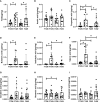Differences in the Gut Microbiota Composition and Metabolites Associated With Feeding Intolerance in VLBW Infants With a Gestational Age of ≤ 30 Weeks: A Pilot Study
- PMID: 35252022
- PMCID: PMC8891543
- DOI: 10.3389/fcimb.2022.726322
Differences in the Gut Microbiota Composition and Metabolites Associated With Feeding Intolerance in VLBW Infants With a Gestational Age of ≤ 30 Weeks: A Pilot Study
Abstract
Objective: To explore the main variations in gut microbiota compositions, short-chain fatty acids (SCFAs) concentrations and autoinducer-2 (AI-2) levels in very-low-birth-weight (VLBW) infants with feeding intolerance (FI).
Methods: Twenty-seven VLBW infants with gestational ages of ≤30 weeks were divided into the FI group (n=14) and feeding tolerance (FT) group (n=13). The gut microbiota composition and SCFAs concentrations and AI-2 levels in feces were detected at 2 and 4 weeks after birth.
Results: There was no difference in alpha diversity between the two groups at 2 and 4 weeks after birth (P>0.05). Although the Chao index decreased (P<0.05), there was no difference in the Shannon index from 2 weeks to 4 weeks in either the FI or FT group (P>0.05). Additionally, there was no difference in beta diversity between the FI and FT groups at 2 weeks (P>0.05), but there was a significant difference in beta diversity between the two groups at 4 weeks (P<0.05) and a large difference from 2 weeks to 4 weeks in both the FI and FT groups (P<0.05). Furthermore, the composition of the microbiota at 4 weeks was significantly different from that at 2 weeks in the FI group (P<0.05). The Veillonella abundance was lower at 4 weeks in the FI group (P<0.05), but there were no differences in the compositions of the other main microbes between the two groups (P>0.05). Proteobacteria and Firmicutes were dominant in both the FI and FT groups. The concentrations of propanoic, valeric and hexanoic acids were lower in the FI group at 2 weeks, and the levels of isobutyric and valeric acids were lower at 4 weeks after birth (P<0.05). The areas under the curves (AUCs) of propanoic, butanoic and valeric acids in predicting FI were 0.878, 0.816 and 0.744, respectively. Compared with that in the FT group, the relative bioluminescence of AI-2 was lower in the FI group at 2 weeks (P<0.05), and the AUC was 0.736.
Conclusions: The main composition of the microbiota was not obviously different in infants with FI. Some SCFAs and AI-2 have moderate value in predicting FI.
Keywords: autoinducer-2 (AI-2); feeding intolerance; gut microbiota; metabolites; short-chain fatty acids (SCFAs).
Copyright © 2022 Liu, Sun, Ji, Fu, Wang, He and Li.
Conflict of interest statement
The authors declare that the research was conducted in the absence of any commercial or financial relationships that could be construed as a potential conflict of interest.
Figures







Similar articles
-
Early gut microbiota in very low and extremely low birth weight preterm infants with feeding intolerance: a prospective case-control study.J Microbiol. 2022 Oct;60(10):1021-1031. doi: 10.1007/s12275-022-2180-2. Epub 2022 Aug 19. J Microbiol. 2022. PMID: 35984614 Free PMC article.
-
Altered gut microbiota is associated with feeding intolerance in preterm infants.Turk J Pediatr. 2021;63(2):206-217. doi: 10.24953/turkjped.2021.02.004. Turk J Pediatr. 2021. PMID: 33929110
-
Citrobacter and Acinetobacter are respectively involved in feeding intolerance in preterm infants of different gestational ages: a prospective case-control study.Ital J Pediatr. 2025 Jun 9;51(1):184. doi: 10.1186/s13052-025-02034-3. Ital J Pediatr. 2025. PMID: 40490820 Free PMC article.
-
Feeding practice influences gut microbiome composition in very low birth weight preterm infants and the association with oxidative stress: A prospective cohort study.Free Radic Biol Med. 2019 Oct;142:146-154. doi: 10.1016/j.freeradbiomed.2019.02.032. Epub 2019 Mar 6. Free Radic Biol Med. 2019. PMID: 30851363
-
Evolution of gut microbiota composition from birth to 24 weeks in the INFANTMET Cohort.Microbiome. 2017 Jan 17;5(1):4. doi: 10.1186/s40168-016-0213-y. Microbiome. 2017. PMID: 28095889 Free PMC article.
Cited by
-
Gut microbiota and short-chain fatty acids may be new biomarkers for predicting neonatal necrotizing enterocolitis: A pilot study.Front Microbiol. 2022 Aug 17;13:969656. doi: 10.3389/fmicb.2022.969656. eCollection 2022. Front Microbiol. 2022. PMID: 36060739 Free PMC article.
-
Feeding intolerance after pediatric cardiac surgery is associated with dysbiosis, barrier dysfunction, and reduced short-chain fatty acids.Am J Physiol Gastrointest Liver Physiol. 2024 Nov 1;327(5):G685-G696. doi: 10.1152/ajpgi.00151.2024. Epub 2024 Sep 3. Am J Physiol Gastrointest Liver Physiol. 2024. PMID: 39224072
-
Succinate aggravates intestinal injury in mice with necrotizing enterocolitis.Front Cell Infect Microbiol. 2022 Nov 28;12:1064462. doi: 10.3389/fcimb.2022.1064462. eCollection 2022. Front Cell Infect Microbiol. 2022. PMID: 36519131 Free PMC article.
-
Postnatal Dynamics and Clinical Associations of Fecal Calprotectin in Very Preterm Infants: Implications for Necrotizing Enterocolitis and Feeding Intolerance.Clin Transl Gastroenterol. 2023 Aug 1;14(8):e00604. doi: 10.14309/ctg.0000000000000604. Clin Transl Gastroenterol. 2023. PMID: 37272666 Free PMC article.
-
Dynamics and Crosstalk between Gut Microbiota, Metabolome, and Fecal Calprotectin in Very Preterm Infants: Insights into Feeding Intolerance.Nutrients. 2023 Nov 20;15(22):4849. doi: 10.3390/nu15224849. Nutrients. 2023. PMID: 38004243 Free PMC article.
References
-
- Alva-Murillo N., Ochoa-Zarzosa A., López-Meza J. E. (2012). Short Chain Fatty Acids (Propionic and Hexanoic) Decrease Staphylococcus Aureus Internalization Into Bovine Mammary Epithelial Cells and Modulate Antimicrobial Peptide Expression. Vet. Microbiol. 155 (2-4), 324–331. doi: 10.1016/j.vetmic.2011.08.025 - DOI - PubMed
-
- Bajic D., Niemann A., Hillmer A.-K., Mejias-Luque R., Bluemel S., Docampo M., et al. . (2020). Gut Microbiota-Derived Propionate Regulates the Expression of Reg3 Mucosal Lectins and Ameliorates Experimental Colitis in Mice. J. Crohns Colitis 14 (10), 1462–1472. doi: 10.1093/ecco-jcc/jjaa065 - DOI - PMC - PubMed
-
- Chi C., Buys N., Li C., Sun J., Yin C. (2019). Effects of Prebiotics on Sepsis, Necrotizing Enterocolitis, Mortality, Feeding Intolerance, Time to Full Enteral Feeding, Length of Hospital Stay, and Stool Frequency in Preterm Infants: A Meta-Analysis. Eur. J. Clin. Nutr. 73 (5), 657–670. doi: 10.1038/s41430-018-0377-6 - DOI - PMC - PubMed
Publication types
MeSH terms
Substances
LinkOut - more resources
Full Text Sources

